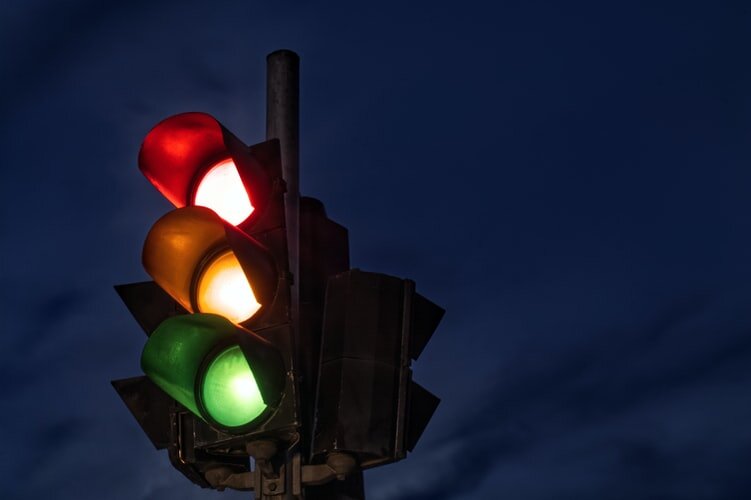The Red, Yellow, & Green Zones

There are lots of emotions in my house. All. The. Time. With six people living here, at any moment, we run the gamut of emotions being thrown around. Anyone else have kids that have tantrums? I see these tantrums in my 1 year old, all the way up to my 11-year-old. They just look a little different. This concept of emotional regulation, however, applies to all ages.
I like to think of emotional states in three zones: green, yellow, and red. I like the visual of a stoplight; this also makes it helpful for kids to remember. I made this Emotional Zones of Regulation chart as a visual of what I will explain in more detail here. (No opt-in or e-mail address, just click and you will have it!) As you will see the green zone is a calm state, the yellow zone is a state of heightened alertness, and the red zone is a full-blown tantrum.
The Red Zone
This is the space where children are when they are melting down and having a tantrum. We all know the behaviors—screaming, throwing things, flopping on the ground, out of control. This is what is happening on the outside of their bodies, while inside things are happening too. Neuroscience tells us that when a human is in the red zone, the limbic system of the brain takes over and the brain causes the child to actually be unable to make decisions and to control impulses. Their CNS (central nervous system) has gone into “fight, flight, or freeze”. This is the part of the scenario where us parents want to MAKE IT STOP. However, it is also the time that most of us go into lecture mode. Guess what? Nothing is getting in. Before our children are able to accept input, their bodies must “turn on” a different part of their brain that is called the pre-frontal lobe. This is the area behind their forehead and it is responsible for executive function and impulse control. (Is this boring you? I find all of this neuroscience fascinating!) Let’s move on to strategies to help your child move out of the red zone.
1. Space/Quiet: This calms the senses that are on high alert. (I have had to sit in the sitting room at our old church’s bathroom with an out of control child for almost an hour for her to calm down. We do what we gotta do, right mamas?)
2. Deep Breathing/Belly Breathing: This is they type of breathing which expands your diaphragm. It is not a natural way to breathe, but the oxygenation that occurs as a result, along with the release of endorphins assist in calming down. Plus, a child can literally do this anywhere.
3. Counting to 10: This forces the brain to concentrate on something else. Again, “firing” a different section of the brain.
The Yellow Zone
This zone is characterized by the rising of senses, which looks different in each child. A child might experience heart pounding, hands sweating or clenched, head spinning, feeling flushed or tense. This is a key zone for us to teach to our children to be keenly aware of their body. If they can recognize their own individual physical responses during this time, they can learn ways to calm back down to the green zone, without escalating to the red zone. Some of the same strategies from above can work to continue to calm back down to the green zone, the key difference being that when a child is in the yellow zone, you can start introducing techniques that involve some gentle stimulation/input. Here are a few ideas, remembering that each child will have a unique set that works for them. Remove the child from the situation.
1. Talk out their feelings.
2. Listen to calming music.
3. Squeeze a stress ball.
4. Sit with a soft blanket or favorite stuffed animal.
5. Get out in nature—take a walk, feel the sunshine or cold temperature.
The Green Zone
This is the happy and calm state where our kids are able to learn, process and intake information, without being flooded with emotion. THIS is the state of mind where it’s great to practice the coping strategies listed above; to teach kids how to listen to their bodies; to reflect on how their emotions are affecting them. This will clearly look different based on your child’s age. A 4 year old, for example: “Remember back at the store when you were screaming and crying so much that we needed to leave the store for you to calm down? Times like that is when your body is showing you that it need a break. God created our bodies in a beautiful way, and you will have to learn how to control your body when you get so angry next time. What did it feel like in your body before you got so upset?” (Prompt with ideas—stomach hurt, heart beating fast, etc.) “Next time you feel like that, you can tell mommy that you are feeling that way and we can try to calm your body down so that you don’t get so angry that we need to leave. Sound like a plan?” Continuing to talk about this when kids are in their green zone will help them retain the information, and formulate a “plan” for what to do to help themselves self-regulate. The words you use and their response/understanding will clearly change based on age. The key here is to bring awareness for each child to what is happening in his/her body as emotions rise, and then teach strategies to de-escalate.
A great side note here is that parents need to know this to, because guess what? This same concept applies to us. We need to be aware of our emotional state so that we can better teach our kids.
Questions? Comments? Hit me up! allison@redefinedmotherhood.com Would love to hear what you think!